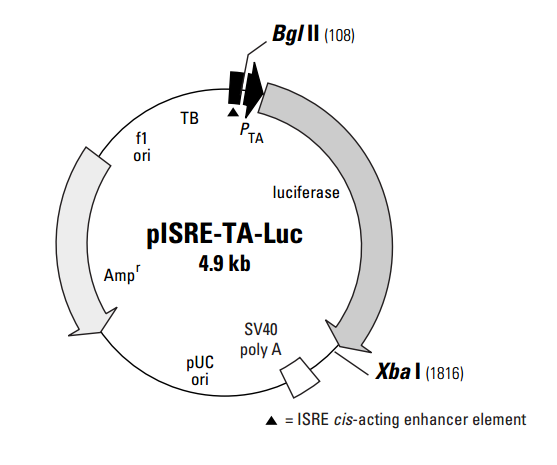pISRE-TA-Luc 载体
| 质粒类型: | 信号通路报告载体 |
|---|---|
| 克隆方法: | 多克隆位点,限制性内切酶 |
| 载体大小: | 4.9kb |
| 载体抗性: | Ampicillin (氨苄青霉素) |
pISRE-TA-Luc is designed for monitoring the induction of the STAT1 and STAT2 components of Jak/STAT-mediated signal transduction pathways. Signaling molecules, including type I (IFN-α and -β) and type II (IFN-γ) interferons (1), induce signalling by binding receptors and causing receptor dimerization at the cell surface. This dimerization causes the receptor itself to be phosphorylated and act as a docking site for transcription factors, including STAT1 and STAT2. The STAT proteins are then phosphorylated, dimerize and translocate to the nucleus, where the STAT1 and STAT2 heterodimer regulates transcription by binding to the IFN-stimulated response element (ISRE; 2). pISRE-TA-Luc contains five copies of the ISRE enhancer element, located upstream of the minimal TA promoter, the TATA box from the herpes simplex virus thymidine kinase promoter (PTA). Located downstream of the PTA is the firefly luciferase gene (luc). Upon binding of the STAT1 and STAT2 heterodimer to the cis-acting ISRE enhancer element, transcription is induced and the reporter gene is activated.
The luciferase coding sequence is followed by the SV40 late polyadenylation signal to ensure proper, efficient processing of the luciferase transcript in eukaryotic cells. A synthetic transcription blocker (TB) is located upstream of the cis-acting enhancer element. It is composed of adjacent polyadenylation and transcription pause sites for blocking nonspecific transcription (3). The vector backbone also contains an f1 origin for single-stranded DNA production, a pUC origin of replication, and an ampicillin resistance gene for propagation and selection in E. coli.
载体应用
pISRE-TA-Luc is is designed for monitoring interferon signaling in mammalian cells by assaying for luciferase activity. For example, you can compare the induction of ISRE-mediated signal transduction pathways across different cell types or cell states by transiently transfecting them into appropriate cell lines. After transfection, treat each culture individually with a drug candidate or stimulus of interest. Then compare the induction of ISRE by assaying for the luciferase reporter gene. Additionally, you can monitor pathway activation by cotransfecting this vector with an expression vector containing a gene of interest. Luciferase is a highly sensitive enzymatic reporter that can be assayed by any standard luciferase-detection method, providing quantitative data on induction levels. pISRE-TA-Luc can be transfected into mammalian cells by any standard method. For selecting stable clones, cotransfect with a vector containing an antibiotic resistance gene, such as neomycin, hygromycin, or puromycin.


